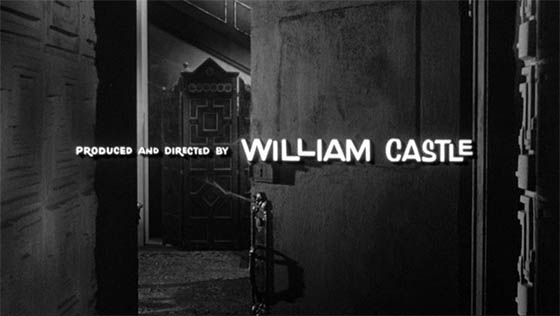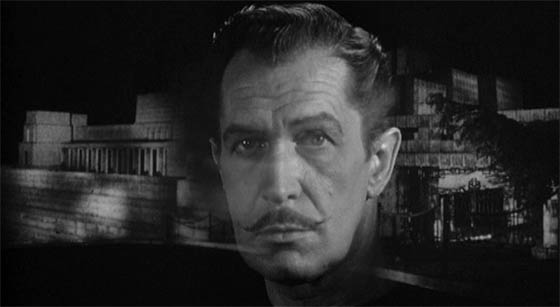 Since July I’ve been posting reviews of the films featured on the William Castle Film Collection DVD box set, encompassing Castle’s run at Columbia Pictures; although his career was far from over, I’d like to close out this survey of his horror work (for now) by circling back to the film that became his breakthrough in the genre, House on Haunted Hill (1959). It wasn’t just a big film for Castle, who had heretofore directed B-pictures in a variety of categories, and had just begun to dabble in horror with Macabre (1958); it also played a significant part in the career transition of Vincent Price. Price had been acting in pictures since the late 30’s, occasionally stealing the spotlight in films such as Laura (1944), Leave Her to Heaven (1945), and His Kind of Woman (1951) – the latter an eccentric little film that allowed Price to display his knack for comedy. He could be the romantic leading man or a sneering villain in a swashbuckler, but in 1953’s 3-D House of Wax he essayed what would become his signature role: the droll murderer, an antihero at the center of a black-humored horror tale. The subsequent one-two punch of The Fly (1958) and House on Haunted Hill fixed this personality in the minds of moviegoers, and cemented him as a cultural icon. When Price agreed to a two-picture deal for Castle (The Tingler quickly followed), horror film history was made.
Since July I’ve been posting reviews of the films featured on the William Castle Film Collection DVD box set, encompassing Castle’s run at Columbia Pictures; although his career was far from over, I’d like to close out this survey of his horror work (for now) by circling back to the film that became his breakthrough in the genre, House on Haunted Hill (1959). It wasn’t just a big film for Castle, who had heretofore directed B-pictures in a variety of categories, and had just begun to dabble in horror with Macabre (1958); it also played a significant part in the career transition of Vincent Price. Price had been acting in pictures since the late 30’s, occasionally stealing the spotlight in films such as Laura (1944), Leave Her to Heaven (1945), and His Kind of Woman (1951) – the latter an eccentric little film that allowed Price to display his knack for comedy. He could be the romantic leading man or a sneering villain in a swashbuckler, but in 1953’s 3-D House of Wax he essayed what would become his signature role: the droll murderer, an antihero at the center of a black-humored horror tale. The subsequent one-two punch of The Fly (1958) and House on Haunted Hill fixed this personality in the minds of moviegoers, and cemented him as a cultural icon. When Price agreed to a two-picture deal for Castle (The Tingler quickly followed), horror film history was made.
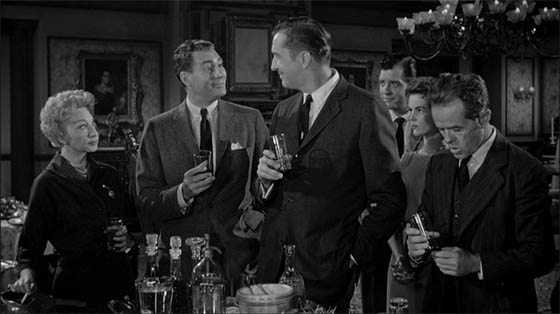
The slumber party begins: (L-R) Julie Mitchum, Alan Marshal, Vincent Price, Richard Long, Carolyn Craig, and Elisha Cook Jr.
It’s a very straightforward film, but efficiently designed and executed, like the stately, severely right-angled Frank Lloyd Wright home which stands in for the titular haunted house (it also featured in Blade Runner). At the outset, we sit in the darkness of the theater listening to sounds that could be coming from any Halloween sound-effects tape: screams, creaking doors, moans, rattling chains; then the head of character actor Elisha Cook Jr. (The Maltese Falcon, The Killing) drifts toward us Zardoz-like. He introduces himself as Watson Pritchard, the owner of “the only real haunted house in the world,” which has claimed several lives, including that of his brother. “I only spent one night there, and when they found me in the morning, I was almost dead.” (If you’ve ever read Richard Matheson’s Hell House, or seen the film The Legend of Hell House, this character and his story might seem familiar. Matheson’s excellent novel borrowed liberally from both this film and Shirley Jackson’s The Haunting of Hill House, published the same year Castle’s film was released.) Price, as the millionaire Frederick Loren, takes over narration duties; he gets to be a floating head too, lucky guy. He explains that he and his wife have invited a small group of strangers to spend an evening at “the House on Haunted Hill,” to meet up at midnight. He introduces the cast one at a time, as they’re conducted to the estate in hearses. In addition to Watson Pritchard, there’s Nora Manning (Carolyn Craig), a pretty young employee of Loren’s company; Ruth Bridges (Julie Mitchum), a newspaper columnist writing an article on ghosts; David Trent (Alan Marshal), a psychiatrist; and cocky test pilot Lance Schroeder (Richard Long). All of them have been lured by what seems to be easy money: survive one night in the house and Loren will award each of them $10,000. They’ve never met Loren, nor do they understand his motives, but they’re in desperate need of the money.
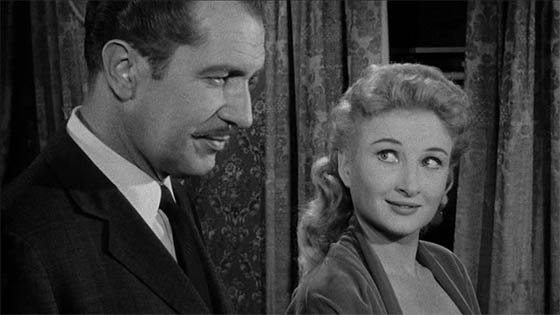
Frederick Loren (Vincent Price) trades insults with his bitter spouse, Annabelle (Carol Ohmart).
But we know that Frederick Loren has been making death threats to Annabelle, his fifth wife, which she is returning in kind. They seem less concerned with the prospect of murderous ghosts, and more with trying to survive another evening of hate-filled marriage. After some Taming of the Shrew-style exchanges of frosty wit in the bedroom, Frederick goes downstairs to introduce himself to his guests, pour some hard liquor, and begin a tour of the house conducted by Pritchard. The house has no electricity, and after midnight the caretakers will lock them inside; to further up the ante, Frederick gives each of them a loaded gun which arrives in a cute little coffin-shaped box. When the party heads down to the cellar, Pritchard displays a trap door which leads to a pool of acid. Nora nearly falls in, so it’s a wonder that she lingers in the dungeon with Lance when the others go upstairs. As the two begin exploring the adjacent closets and rooms, a door suddenly slams shut between them, Lance is knocked unconscious, and Nora watches all the candles in the room flicker out one-by-one, before she sees an eerie-looking woman with white hair and white eyes drifting toward her out of the darkness. She screams and runs for help, and Lance is shortly rescued, nursing a bad bruise. Refusing to learn their lesson, a few short scenes later and Lance and Nora are exploring the basement alone again. They’re once more separated, and Nora now comes face to face with the ghostly woman, who sneers at her from a few inches away. She screams, and when Lance reaches her a moment later, the old woman is gone. Not to worry: when they return upstairs, they learn that Nora’s ghost is actually just the blind wife of the caretaker; we can only assume she’s given to wandering around in the cellar with the acid pool, lurking in closets and jumping at strangers, just for kicks.
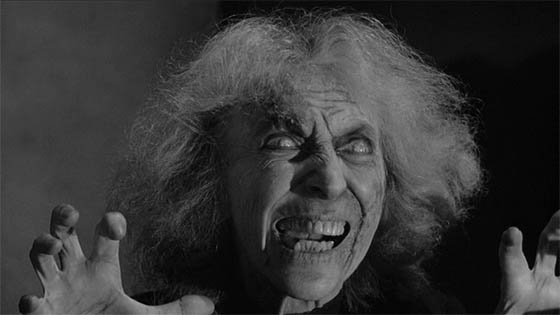
Not a ghost, but an incredible simulation: the blind caretaker.
Here’s the thing: as utterly ridiculous as this sequence of events is – I love it. It has a nightmare logic which is perfect for young, impressionable kids who have no idea how absurd and silly this all is. That Nora is left alone twice, and that on the second occasion the hideous spectre she glimpsed from a distance is now suddenly right before her, bad-breath-close, is just the kind of campfire folklore that drives straight to the center of the nervous system for every bedwetter daring to watch the film between sweaty fingers. But William Castle has a few more tricks up his sleeve. First Frederick’s wife Annabelle is found hanging from a noose in the stairwell. (That’s right – someone manages to laboriously rope her up in the most heavily trafficked section of the house, and nobody witnesses this.) After her corpse is tucked back into bed, the haunting really moves into full swing. Nora is chased from one corner of the house to another, and finds herself at the end of her rope – literally. She witnesses Annabelle’s ghost lurking outside her bedroom window, and one end of the cord that hanged her moves, animate, into Nora’s room and wraps itself around her legs. Later she finds a bloody head in her luggage, and a cobweb-covered organ that plays its own ghostly tune; she even has to fight off a monstrous hand that grasps at her from around a corner. In other words, she’s in a carnival funhouse: always the atmosphere that William Castle revels in. We soon learn that Annabelle is still alive, anticipating that the hauntings hide her escape with her lover, psychiatrist Dr. Trent. She’s also planned to have her husband murdered at the hands of Nora, who’s been driven to manic hysteria, and shoots Frederick as soon as she sees him. (That this plan actually works is as ludicrous everything else in the picture.) But after it seems that Frederick’s been dissolved in the acid bath, the undead millionaire rises as a walking skeleton. The skeleton chases Annabelle into the acid, and Frederick emerges from the shadows, operating the device with strings: the great puppetmaster. Nora’s gun, it seems, was deliberately loaded with blanks. Frederick has triumphed over his fifth wife after all.
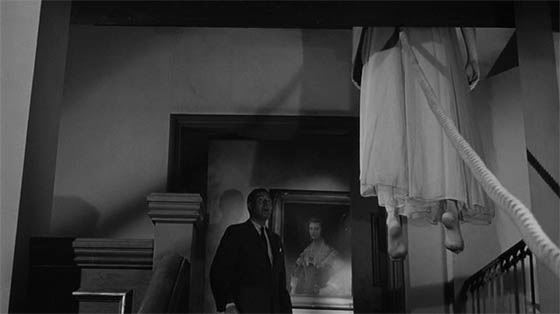
Dr. Trent (Alan Marshal) discovers the body of Annabelle.
Castle had initiated his series of famous marketing gimmicks with his previous film, Macabre, in which life insurance policies were issued to the audience members in case the film scared them to death. For House on Haunted Hill, he decided to make the moviegoing experience more interactive. He introduced “Emergo,” a one-of-a-kind technique that would never be utilized again. When Vincent Price’s skeleton appeared onscreen at the film’s climax, a glow-in-the-dark skeleton was dangled on a wire over the audience’s heads. William C. Wind, a witness to Emergo, wrote to DVD Talk’s Glenn Erickson in 2005, describing the gimmick thus: “As I waited for House on Haunted Hill to start, I noticed a small black booth that had been mounted by one end of the screen. The booth was painted black, with a black curtain on the front. From the booth, a thin wire could be seen leading up to the opposite end of the balcony (I was seated downstairs). When the big scene began and Vincent Price began cranking, a skeleton emerged from the booth and slowly climbed up the wire toward the balcony. Immediately, all the teenage girls in the audience (and some of the boys) began screaming in mock horror.” As cheesy as the technique was, showman Castle received such great publicity that he immediately began plotting a topper – an escalating series of theater pranks which would secure his reputation: The Tingler, 13 Ghosts, Homicidal, and so on. After The Tingler, Price formed a new partnership with a different kind of huckster: young Roger Corman, who initiated a lucrative series of Edgar Allan Poe adaptations beginning with House of Usher (1960). I imagine it was a grand time to be a frightened young child.
